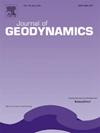Probing the active kinematics in northwestern Himalayan foreland, Pakistan: Insights from seismicity and gravity data
IF 2.1
3区 地球科学
Q2 GEOCHEMISTRY & GEOPHYSICS
引用次数: 0
Abstract
Active tectonic forces and elements along northwestern Himalayan foreland have been probed through determination of seismic parameters duly substantiated by gravity data analysis. Local broadband waveform data of seven moderate to small size earthquakes recorded by CES and PMD networks was analyzed for resolving focal mechanisms and stress orientation. These predominantly strike-slip seismic events represent NW-SE oriented causative faults while the maximum horizontal stress (SHmax) is oriented in the NNW–SSE direction that mimics the Indo-Eurasian plate convergence. Depicted structure was corroborated through analysis of TOPEX satellite gravity data. Shallow right-lateral strike-slip faults observed in gravity data are consistent with the determined focal mechanism solutions. The residual and regional gravity data validates variation in faulting styles with depth as observed in seismic studies. The predominant shallow strike-slip faulting may be associated with interaction of Himalayan thrust and fold-belt with the Indian flexural forebulge known as Sargodha-Delhi basement ridge. Considering these faults to be R-shears of the western plate boundary, i.e. Chaman fault system may provide an alternate tectonic explanation. Total slip in the area, seems to be occurring partly aseismically along viscous decollement in the Himalayan Front i.e. Salt Range and partly seismically through brittle deformation of the basement ridge.
巴基斯坦喜玛拉雅山西北部前陆活动性的探测:来自地震活动性和重力资料的见解
通过地震参数的确定和重力资料的分析,探讨了喜玛拉雅山西北前陆的活动构造力和构造要素。对7次中小地震的局地宽带波形数据进行了分析,以确定震源机制和应力方向。这些以走滑为主的地震事件代表了北西-东南向的成因断裂,而最大水平应力(SHmax)则是北西-南西向的,模拟了印度-欧亚板块的辐合。通过对TOPEX卫星重力数据的分析,证实了所描绘的结构。重力资料中观测到的浅层右旋走滑断层与确定的震源机制解一致。残差和区域重力数据验证了地震研究中观察到的断层样式随深度的变化。主要的浅层走滑断裂可能与喜马拉雅逆冲褶皱带与印度弯曲前隆起萨戈达-德里基底脊的相互作用有关。考虑到这些断裂是西板块边界的r -剪切,即查满断裂系统可能提供另一种构造解释。该地区的总滑移似乎部分是沿着喜马拉雅前缘即盐岭的粘性滑脱发生的,部分是通过基底脊的脆性变形发生的。
本文章由计算机程序翻译,如有差异,请以英文原文为准。
求助全文
约1分钟内获得全文
求助全文
来源期刊

Journal of Geodynamics
地学-地球化学与地球物理
CiteScore
4.60
自引率
0.00%
发文量
21
审稿时长
6-12 weeks
期刊介绍:
The Journal of Geodynamics is an international and interdisciplinary forum for the publication of results and discussions of solid earth research in geodetic, geophysical, geological and geochemical geodynamics, with special emphasis on the large scale processes involved.
 求助内容:
求助内容: 应助结果提醒方式:
应助结果提醒方式:


